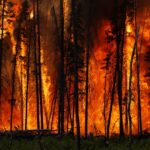ESSIC assistant research scientist Ariana Sutton-Grier was a featured expert on “Ocean Currents,” a radio show based out of NOAA’s Cordell Bank National Marine Sanctuary.
During the October segment, Sutton-Grier discussed the importance of coastal wetlands, or blue carbon, in the fight against global climate change.
Sutton-Grier explained the different color terms associated with carbon emission and sequestration; green carbon is carbon stored by vegetation on land, while black carbon is emitted from burning fossil fuels and other land changes. She described blue carbon as, “carbon taken up and stored in coastal and marine ecosystems.”
Interestingly, Sutton-Grier continued that although coastal wetlands–including salt marshes, sea grasses and mangroves–account for only .2 percent of the ocean’s coastal surface, it contributed roughly “47 percent of the carbon burial in marine and coastal sediments.”
Sutton-Grier said that most of the carbon stored in forests is contained within biomass, which scientists can see because it’s visible within the wood of trees and in other landmass features. Coastal wetlands however, store carbon in the soil, “so it’s hidden from us,” she said.
Sutton-Grier noted that mangroves however–shrubs or small trees that grow in coastal saline or brackish water–actually store carbon in both biomass and sediments.
When asked about kelp, large seaweeds that grow in “underwater” forests, Sutton-Grier explained that while kelp can be enjoyable as a food product, it doesn’t sequester carbon on a long-term scale. Tidal marshes conversely noted Sutton-Grier, were resilient ecosystems and can play an important role with respect to sea level rise, but only if the systems were part of a “healthy coastal ecosystems.”
To listen to the interview in its entirety, please see the following: http://cordellbank.noaa.gov/casts/mp3s/oc100416.mp3





